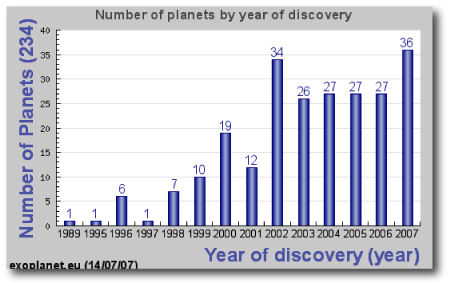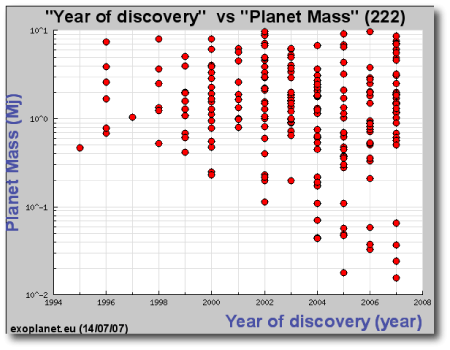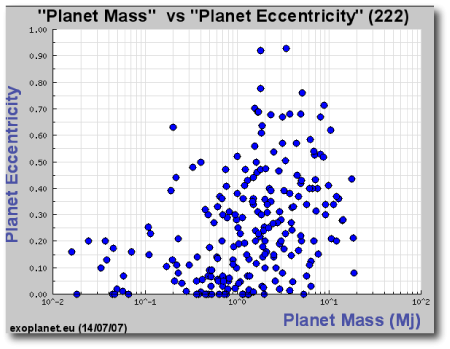
Image Source.
On Thursday and Friday of last week, the Dow Jones Industrial Average jumped nearly 2%. Given the soaring price of oil and the subprime mortgage crisis, many students of the financial markets were puzzled by this seeming burst of irrational exuberance.
A visit to exoplanet.eu, however, suggests that investors and speculators were placing buy orders in response to the rapid recent increase in the number of known planets. During the first two quarters of ’07, the extrasolar planet detection rate has been running more that 100% above the rate reported for the most recent full fiscal year.

When asked about the impact of the new discoveries, one metals trader was quoted, “Well, Mate, the Marketplace has been pricing in the core-accretion theory for several years now. That means we’re looking at a Z of ~0.1 for each one of these planets coming in, so that’s roughly 30 Earth masses of ore per extrasolar planet. If we use the solar gold assay, that works out to one quintillion ounces of new proven reserves for each discovery. With gold at $660, we’re starting to talk real money.”
Jocularity aside, the raft of new planet discoveries is having a noticeable impact on the correlation diagrams that can be explored at the exoplanets.eu site. One (likely statistically insignificant) curiosity is the lack of Saturn-mass planets in this year’s crop to date. At the low-mass end, Neptunes such as Gl 674b are turning up with increasing frequency, and the detection-rate for Jupiter-mass planets and above also remains strong. This dichotomy is very much in line with a key prediction of core-accretion in its simplest form. The rapid gas accretion that occurs once the planet mass reaches ~30 Earth masses should tend to make Saturn-mass planets relatively rare.

Another interesting diagram results when one plots the masses and eccentricities of the known RV-detected planets. A glance at the resulting diagram indicates that low-mass planets tend to be on more circular orbits. Could this be hinting at two populations of planets and (perhaps) two different formation mechanisms? It’s hard to tell. Much of the effect comes from the fact that low-mass planets need to have short periods in order to be detectable. Short-period planets, in turn, are far more affected by tidal circularization of the orbits. The plot is also reflecting the still-mysterious (but well known) shortage of high-mass hot Jupiters.


Talking of possible planet populations, what do you make of this paper on statistical exoplanet taxonomy?
Hi Andy,
I think that techniques like the ones that they’re using there are interesting to experiment with, and indeed by running “chi-by-eye” analyses on the exoplanet.eu plots, one is using a home-brew neural network to do much the same thing. I’d be very leery, however, of submitting anything along these lines to peer-review. My gut feeling is that its unlikely that any fundamentally new and correct insights will emerge from the clusters identified in that paper. It’s very hard to get a correct handle on the profusion of subtle and unavoidable observational biases that underlie the planet catalog. In addition, with any scheme that looks for patterns and then generates hypotheses, it’s very hard to steer clear of the data snooping bias.
Greg, aren’t very high eccentricity planets harder to detect, for a given mass and semimajor axis?
In our solar system, the small planets (and sub-planets) have the highest eccentricity.
Also, how much does the interest in life impact the types of stars that are targetted for planetary searches (variables, very large, etc.)?